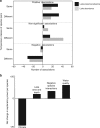Context-dependent interactions and the regulation of species richness in freshwater fish
- PMID: 29511186
- PMCID: PMC5840330
- DOI: 10.1038/s41467-018-03419-1
Context-dependent interactions and the regulation of species richness in freshwater fish
Abstract
Species richness is regulated by a complex network of scale-dependent processes. This complexity can obscure the influence of limiting species interactions, making it difficult to determine if abiotic or biotic drivers are more predominant regulators of richness. Using integrative modeling of freshwater fish richness from 721 lakes along an 11o latitudinal gradient, we find negative interactions to be a relatively minor independent predictor of species richness in lakes despite the widespread presence of predators. Instead, interaction effects, when detectable among major functional groups and 231 species pairs, were strong, often positive, but contextually dependent on environment. These results are consistent with the idea that negative interactions internally structure lake communities but do not consistently 'scale-up' to regulate richness independently of the environment. The importance of environment for interaction outcomes and its role in the regulation of species richness highlights the potential sensitivity of fish communities to the environmental changes affecting lakes globally.
Conflict of interest statement
The authors declare no competing interests.
Figures



References
-
- Steffen W., et al. Global Change and the Earth System: A Planet Under Pressure (Springer-Verlag Berlin, New York, 2004).
-
- MacArthur, R. H. Geographical Ecology: Patterns in the Distribution of Species (Princeton University Press, 1972).
-
- Ricklefs RE, Schluter D. Species Richness in Ecological Communities. Chicago, IL: University of Chicago Press; 1993.
Publication types
MeSH terms
LinkOut - more resources
Full Text Sources
Other Literature Sources

